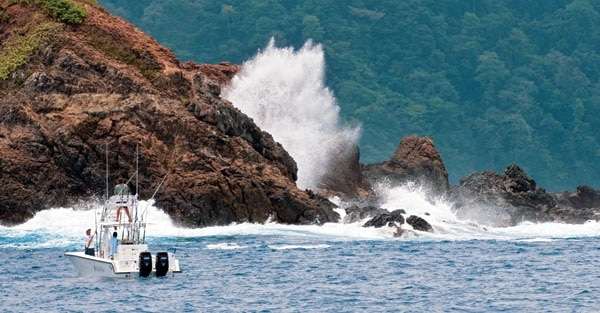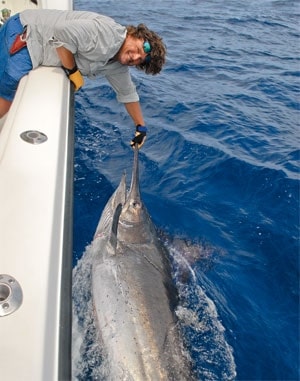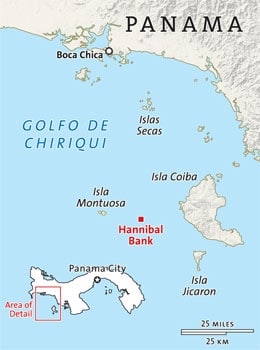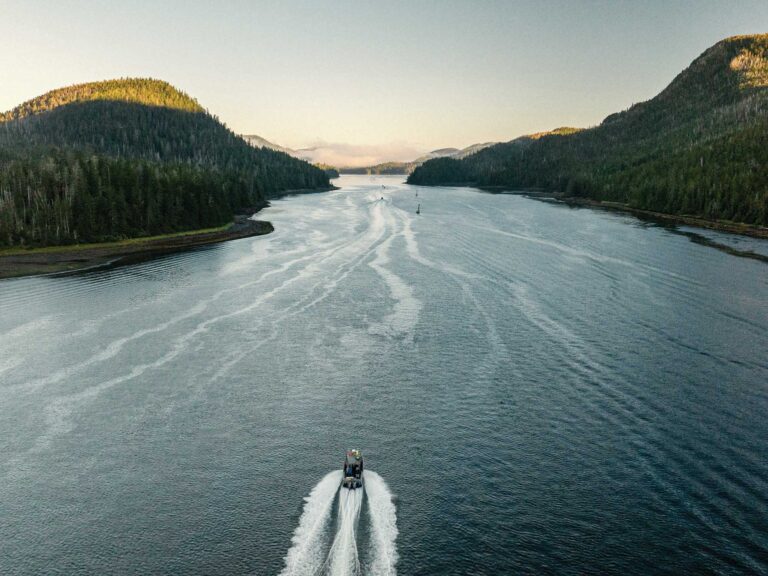
The flock of birds came into our view just over a mile from the waypoint entered into the boat’s GPS, and shortly after we saw the birds, we saw the porpoises. A large school swam back and forth across the seamount known as Hannibal Bank, and as we strained our eyes in the morning light, we began to catch glimpses of what we had come for – yellowfin tuna.
The tunas and porpoises often swim together in the Pacific, and as guide Carter Andrews slowed the boat and we all grabbed stout spinning rods, we realized just how many of each species there were. We could see hundreds of tunas cruising in several large schools, which meant that thousands more likely swam beneath us. Andrews’ mate, Juan Spragge, wasted no time watching as he positioned each of us along the gunwale of the center console and told us to await the order to cast.
**Send Out the Poppers
**Andrews steered the boat in front of an advancing school, and when the fish came within range, Ariel Pared, Raul Riviera and I wound up and heaved large popping plugs as far as we could, chugging them back toward the boat as quickly and noisily as possible. Spragge cast too, and as the tunas and porpoises passed, we retrieved our lures to make another pass.
It took several attempts, but Spragge finally hit pay dirt. A huge fish exploded on his lure in a giant splash after only a single popping motion, and the 60-pound braid screamed off the reel as the tuna sounded. “Nice work, Juan,” Andrews said as Spragge passed the rod to Riviera, who settled in for what would be a long fight. The fish went very deep before settling down, and when it did, Riviera began the laborious task of trying to winch it back to the surface.
He brought the fish close several times, but the tuna would simply sound again, taking another strong run downward. A little over two hours into the fight, we at last saw color beneath the boat. The crew, who had lapsed into lethargy during the long struggle, suddenly became energized and readied gaffs in anticipation of the endgame. “Take your time, Raul – don’t try to force it,” Andrews said, and Riviera patiently worked the fish closer a few inches at a time.
When the fish came within gaffing range, Spragge leaned far overboard trying to grab the leader while I stood by with a gaff, but the fish had one strong surge left and sprinted down and under the boat suddenly and violently. The line touched the bottom of the hull, and the fish was gone. We estimated the tuna at close to 200 pounds. Everyone stared at one another in disbelief before we all finally laughed, and someone said, “That’s fishing!”
Undeterred, we re-rigged and began casting the poppers again. We managed to land several nice fish but didn’t hook another giant that day. Riviera will likely repeat the story of the big one that got away at Hannibal Bank for many years to come!
**Hannibal and Coiba
**

I had traveled to Panama to check out the Islas Secas Reserve and Resort, a new fishing operation located in the Gulf of Chiriqui, in the Islas Secas chain of islands (see SWS Planner). The lodge’s proximity to two of the most famous fishing areas in all of Panama – Hannibal Bank and Coiba Island - had piqued our interest and made the trip irresistible.
Coiba was home to the now-defunct Club Pacifico, a fishing camp famous among traveling fishermen in the 1970s and ’80s. But Manuel Noriega closed Club Pacifico many years ago, and I had never made it there, so this was my first visit to the area.
**
Black Marlin Central
**Hannibal Bank is so named because it was discovered by the U.S. Navy survey ship USS Hannibal as it performed depth soundings and surveys in preparation for the opening of the Panama Canal in 1914. The bank sits along the edge of the Pacific continental shelf and rises to within 120 feet of the surface in some spots. It’s a natural aggregation spot for bait, and thus attracts a wide variety of predators.
In addition to the tuna, which you can reliably expect to find there on most days, Hannibal Bank offers spectacular marlin fishing. Many black and blue marlin have been caught here, and live-baiting with tunas bridled to large circle hooks works best, although you can catch them on lures as well. But given that the marlin have come for a tuna dinner, why not offer them what they came for?
A couple of days after losing the big tuna, we hit Hannibal Bank again, this time in search of a marlin. It didn’t take long to find one. We first caught several small tunas on spoons, and Spragge rigged one on a circle hook with 400-pound-test leader and dropped it back on a Shimano Tiagra 50 Wide spooled with 80-pound line. The porpoises ate a couple of our baits, forcing us to re-rig several times, but on the third bait, the outrigger pin snapped and line began melting off the Tiagra, slowly at first, then with increasing speed.
None of us had seen the bite, and at first we thought another porpoise had attempted to steal the bait, but it soon became clear we were hooked to something large. My wife, Poppy, had taken the rod and was fastened securely to the fish, working on it with a harness-and-belt setup that gave her maximum leverage.
Andrews, Spragge and I speculated about whether this could be another huge tuna, but after about 45 minutes, the line angled upward and the bill of a black marlin of about 400 pounds broke the surface. We were elated, and after another 30 minutes, the tired fish came alongside the boat, where Andrews and Spragge released it as I shot a few photos.
**Inshore Opportunity Galore
**We alternated between fishing Hannibal Bank and casting plugs around the numerous rock islands closer to Islas Secas. We caught dozens of cubera snappers and a few bluefin trevallies and lost a few very large roosterfish. The amount of habitat in the area boggles the mind – you could literally spend years exploring the rocky shorelines of the islands large and small and never fish it all. This place is a caster’s dream.
We also fished around Isla Montuosa, a beautiful uninhabited island west of Hannibal Bank. Montuosa rests on the edge of the drop-off just like the bank and can be equally productive. Plus it has deep pockets of water flowing around it on the east and west sides, where strong currents can create incredible rips. These hold huge dorado, of which we caught many, as well as tuna and billfish. We had a brief encounter there with a lit-up blue marlin of 500-plus pounds but failed to get a hook in it.
The establishment of the Islas Secas Reserve and Resort has once again allowed fishermen easy access to these incredible fishing spots: Isla Coiba, Hannibal Bank, Isla Montuosa and the numerous small islands of the Gulf of Chiriqui offer spectacular fishing for a wide variety of species, from snappers to black marlin. Whether you like light-tackle casting or billfishing on heavy tackle, there’s almost limitless opportunity for you in this amazing part of Panama.
**
**
Islas Secas, Panama

The Islas Secas Reserve and Resort isn’t actually new; it has been around for a while as an eco-tourism lodge, but the new owner wanted to add a fishing focus and brought in Carter Andrews to do it. Andrews ran a fishing lodge in Crooked Island, Bahamas, for many years, and is also well known as a Wyoming trout guide in the summer. “I had enjoyed some great fishing before, but never had I experienced this variety of species,” Andrews says, “and the average size of the fish here in Panama is amazing.”
Andrews put together a fleet of 34-foot SeaVee center consoles with Suzuki outboard power and assembled a tackle arsenal of top-quality Shimano equipment. He has a well-trained staff of captains and mates who provide a professional fishing experience. There’s also a 58-foot Donzi on site if you prefer a more upscale ride.
Islas Secas houses guests in yurts, canvas dwellings supported by wood frames and set on concrete floors. While not air-conditioned, the yurts have fans and provide all the comfort you need. The yurts are spread around the island in private locations, and many offer breathtaking views. Meals are served in the Terrazza, a scenic indoor-outdoor dining area where the staff does an extraordinary job of providing gourmet food and beverage service.
Islas Secas Reserve and Resort
Islas Secas, Chiriqui, Panama
646-837-0705
info@islassecas.com
www.islassecas.com









